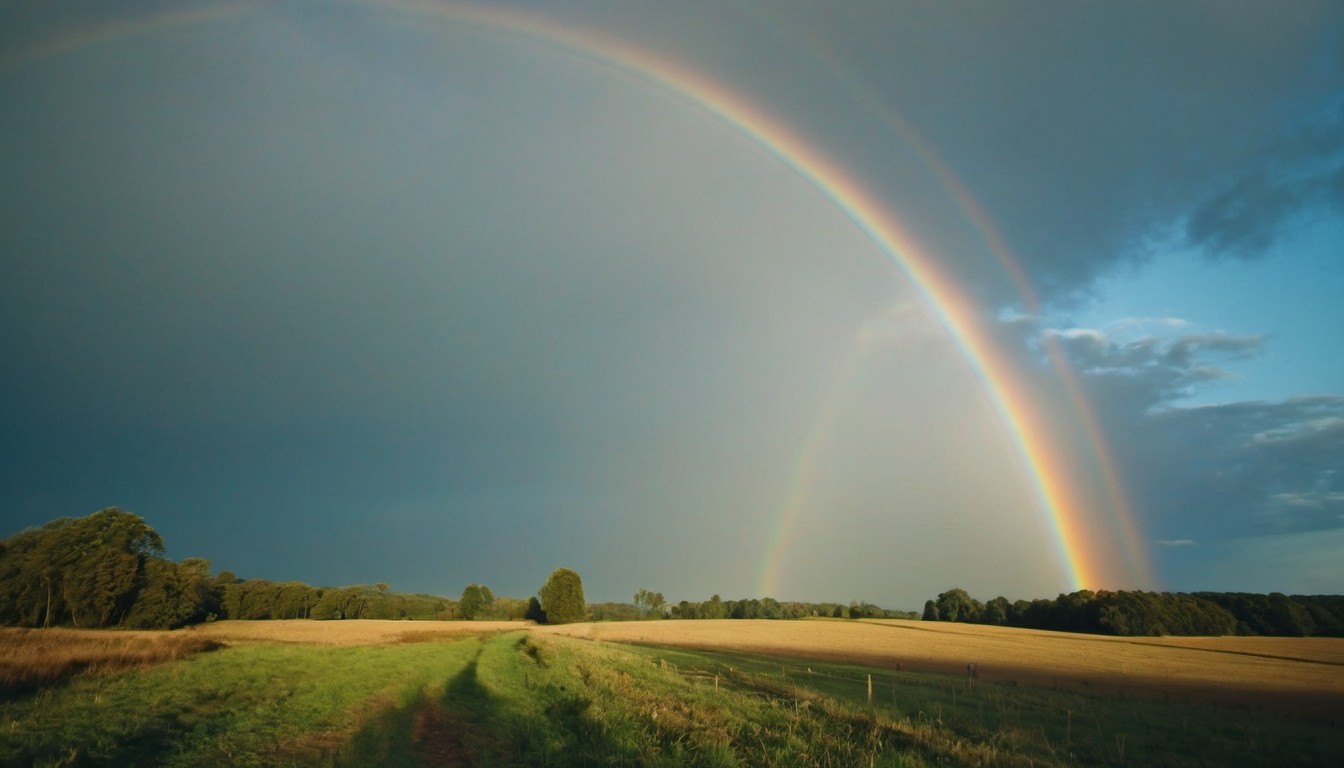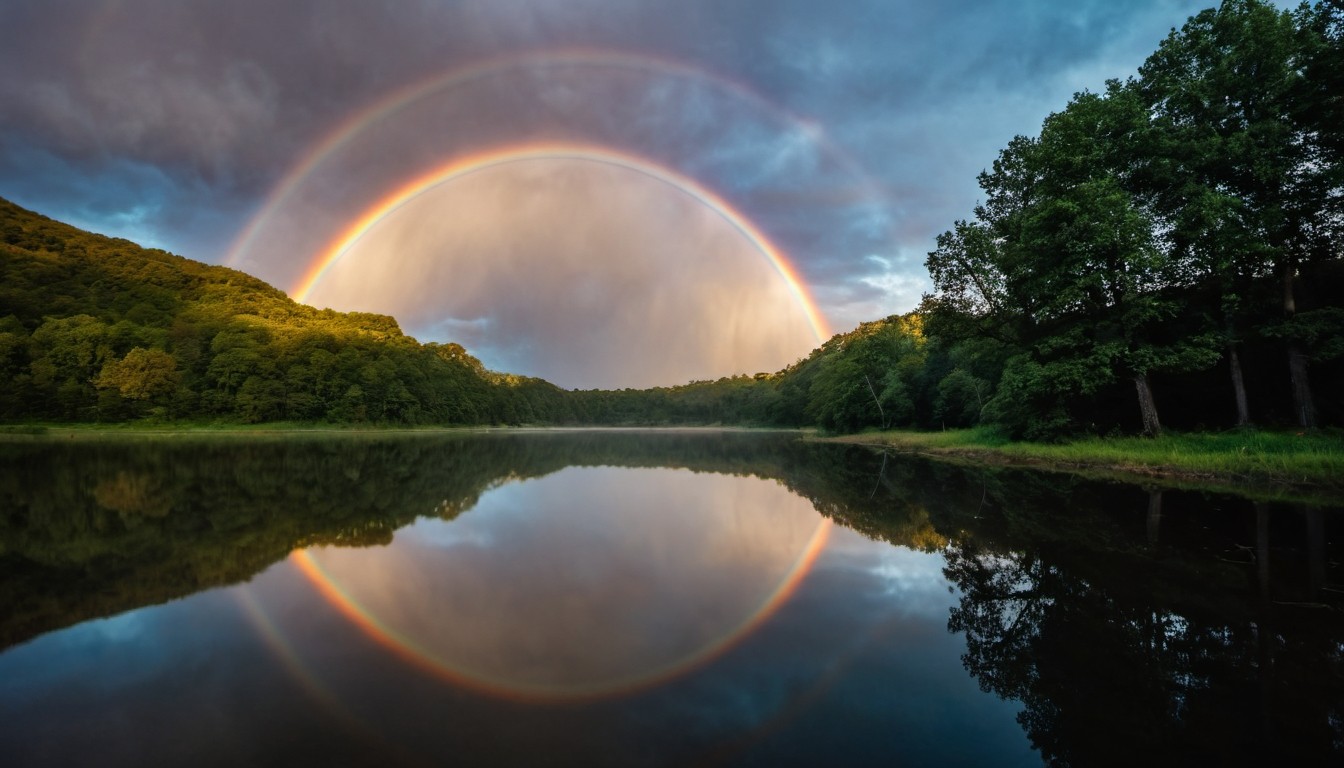Rainbows are one of nature’s most beautiful and mesmerizing phenomena. These colorful arcs appear in the sky after rain showers when sunlight interacts with water droplets. Let’s explore the fascinating world of rainbows and learn more about their formation, types, and interesting facts.
What is a Rainbow?
A rainbow is a multicolored arc that forms in the sky when sunlight passes through rain droplets. The light is refracted, or bent, as it enters the droplet, then reflected inside the droplet, and refracted again as it exits. This process breaks the light into its constituent colors, creating a spectrum.
How Does a Rainbow Form?
For a rainbow to form, three things are needed: sunlight, rain, and the correct angle of observation. When sunlight encounters rain droplets in the atmosphere, it is bent and split into different colors.
The light is then reflected off the inside surface of the droplet and bent again as it leaves the droplet. This combination of refraction and reflection creates the circular arc of a rainbow.
Colors of a Rainbow
A rainbow typically displays seven colors: red, orange, yellow, green, blue, indigo, and violet. These colors appear in this order from the outer edge to the inner edge of the arc. The colors are the result of the dispersion of light, with each color corresponding to a different wavelength of light.
Types of Rainbows
Primary Rainbow
The primary rainbow is the most common type and is the result of one reflection inside the water droplets. It appears as a single, bright, multicolored arc in the sky.
Secondary Rainbow
 A secondary rainbow forms outside the primary rainbow and is fainter and more spread out. It is the result of two reflections inside the water droplets and has its colors reversed, with red on the inside and violet on the outside.
A secondary rainbow forms outside the primary rainbow and is fainter and more spread out. It is the result of two reflections inside the water droplets and has its colors reversed, with red on the inside and violet on the outside.
Supernumerary Rainbow
A supernumerary rainbow appears as faint, closely spaced, additional arcs inside the primary rainbow. These are caused by the interference of light waves.
Reflection Rainbow
 A reflection rainbow occurs when sunlight reflects off a body of water before reaching the rain droplets. This type of rainbow can appear above the horizon, parallel to the primary rainbow.
A reflection rainbow occurs when sunlight reflects off a body of water before reaching the rain droplets. This type of rainbow can appear above the horizon, parallel to the primary rainbow.
Interesting Facts About Rainbows
- Full Circle: Rainbows are actually full circles. However, we usually see only a semi-circular arc because the ground obstructs the bottom half.
- No Two Alike: Each person sees their own unique rainbow, as the angle of light reflection and refraction is different for each observer.
- Double Rainbows: When conditions are right, a double rainbow can occur, with a secondary, fainter rainbow appearing outside the primary one.
- White Rainbow: Also known as a fogbow, a white rainbow appears in foggy conditions and has a white or very faintly colored appearance due to smaller water droplets.
- Rainbow Myth: There is no pot of gold at the end of a rainbow, as rainbows have no specific end point.
- Rainbow Angle: The angle of refraction and reflection that creates a rainbow is typically about 42 degrees from the direction opposite to the sun.
- Cultural Significance: Rainbows hold significant meaning in various cultures, often symbolizing hope, promise, and diversity.
- Rainbows on Other Planets: Rainbows can theoretically form on other planets if they have sunlight and rain or liquid particles in their atmosphere.
- Rainbow Etymology: The word “rainbow” comes from the Old English “renboga,” meaning “rain bow.”
- Halo Effect: Sometimes, a halo effect can be seen around the sun or moon, caused by ice crystals in the atmosphere rather than water droplets.
- Moonbows: Moonbows, or lunar rainbows, occur at night when moonlight, which is sunlight reflected off the moon, interacts with rain droplets.
- Artificial Rainbows: Rainbows can be artificially created using sprinklers, misters, or other devices that produce fine water droplets.
- Scientific Study: Rainbows have been studied scientifically since ancient times, with significant contributions from scholars like Isaac Newton, who explained the dispersion of light.
- Rainbow Bridges: In Norse mythology, a rainbow bridge called Bifröst connects Earth to Asgard, the realm of the gods.
- Rainbow Festivals: Some cultures celebrate rainbows with festivals and events that highlight their beauty and significance.
- Rainbows in Literature: Rainbows often appear in literature as symbols of hope, promise, and new beginnings.
- Colorblind Rainbows: People with colorblindness perceive rainbows differently, often seeing fewer colors or variations in intensity.
- Underwater Rainbows: Divers can sometimes see underwater rainbows, known as “snell’s window,” caused by light entering water at specific angles.
- Inverted Rainbows: Inverted, or circumzenithal, rainbows can occur when light passes through ice crystals in the atmosphere, creating a smile-shaped arc.
- Rainbows and Weather Prediction: Some folklore suggests that seeing a rainbow can predict changes in weather, though this is not scientifically accurate.
- Digital Rainbows: With advancements in technology, rainbows can be simulated and studied using computer models and digital visualization tools.
- Longest-lasting Rainbow: The longest-lasting rainbow on record appeared over Sheffield, England, in 2017, lasting nearly 9 hours.
- Rainbows and Refraction: The study of rainbows has significantly contributed to our understanding of light refraction and optics.
- Rainbows in Religion: In Christianity, rainbows are seen as a sign of God’s promise to Noah after the great flood.
- Endless Pursuit: Because a rainbow moves with the observer, it’s impossible to reach the “end” of a rainbow.
- Global Rainbows: Rainbows can be seen all over the world, wherever there is sunlight and rain.
- Circular Rainbows from Above: From an airplane, passengers can sometimes see a full circular rainbow.
- Rainbow Clouds: Occasionally, clouds can produce rainbow colors due to diffraction, creating a phenomenon known as iridescence.
Rainbows are a stunning natural phenomenon that captivate people all over the world. From their scientific formation to their cultural significance, rainbows continue to inspire awe and wonder.
